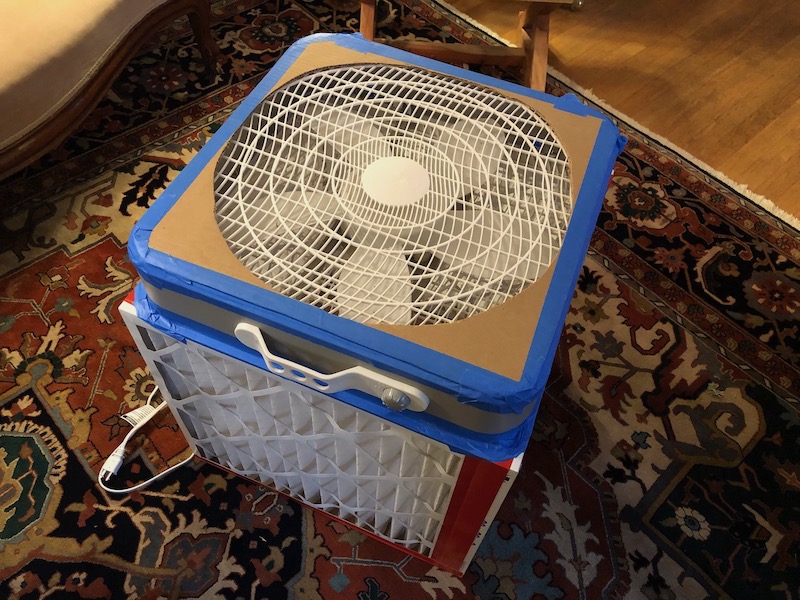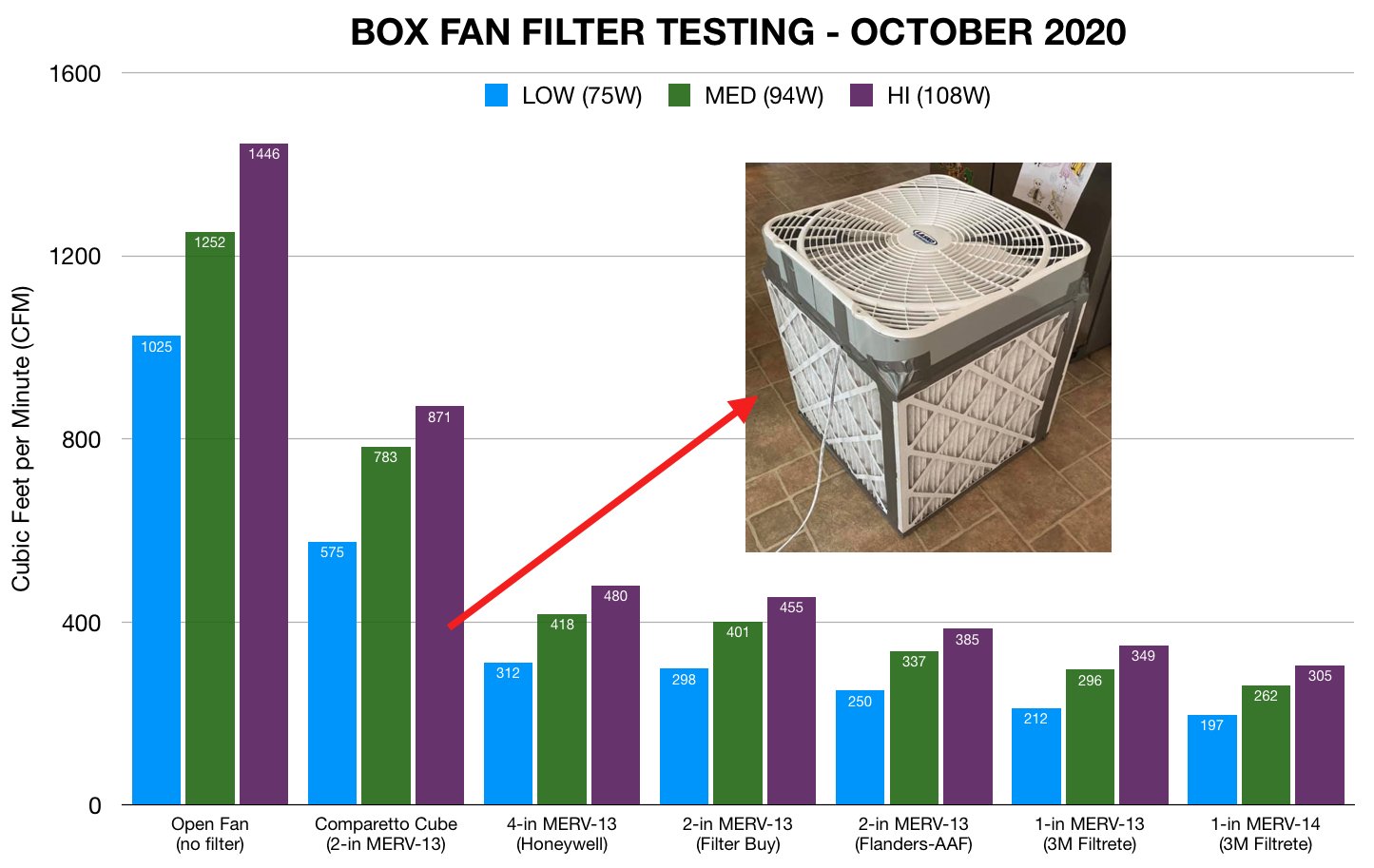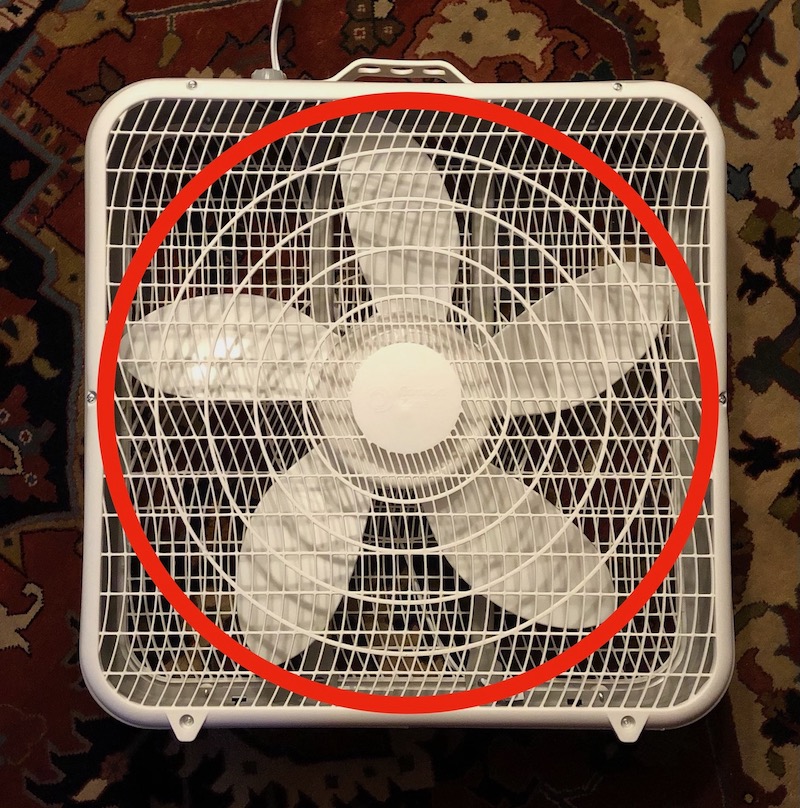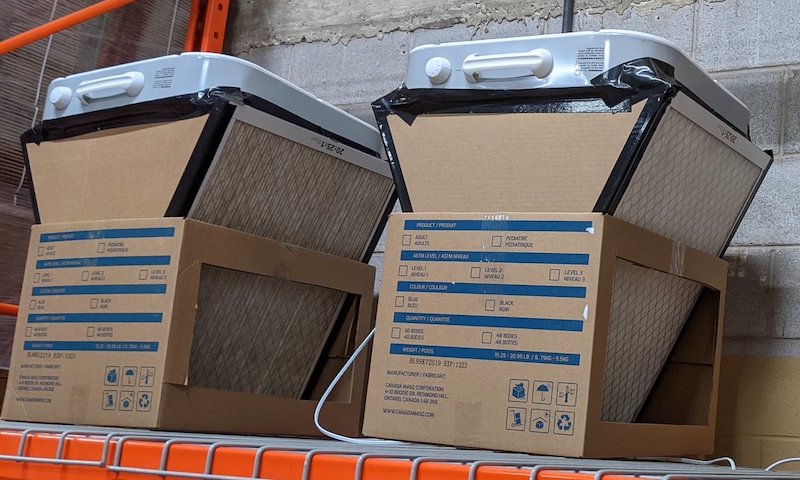DIY Box Fan Air Cleaner Update

The DIY box fan air cleaner known as the Corsi-Rosenthal Box (or the Comparetto Cube, in a slight variation) has really taken off in the fight against COVID. I wrote about it here in September 2020, with instructions on how to make one yourself after I made my first one. I just changed the filters on mine yesterday, so it’s a good time for a little update on this clever device.
Does it work?
I guess it shouldn’t surprise me anymore, but I’ve seen some people claiming it won’t work or won’t last long or it works but it won’t help with COVID. So here’s a quick review.
- Particulate matter in the 2.5 micron and smaller range is the worst for human health overall.
- Particles carrying active viruses, like the SARS-COV-2 responsible for COVID-19, come in a lot of different sizes.
- The small particles that stay airborne for hours are responsible for a lot of the COVID infections. (Unfortunately, the CDC and WHO have been slow to recognize this and promote the obvious solutions.)
- Filters remove particles from the air.
- High-efficiency filters remove more particles and smaller particles. MERV-13 is where you want to be.
- Taping one MERV-13 filter works, but the high resistance reduces its effectiveness. It also needs to be replaced sooner than the Corsi-Rosenthal Box or Comparetto Cube configurations.
- Two filters is better than one because of the reduced resistance.
- Four or five filters is best. It has great air flow, as measured by John Semmelhack and Neil Comparetto. (See chart below.) That means it has a great Clean Air Delivery Rate (CADR) when you use MERV-13 filters.

Recognition for the box fan air cleaner
Since I first wrote about the DIY box fan air cleaner in 2020, it has really taken off. People have been making for their homes and offices. Parents and teachers have had their students make them as class projects. It’s been the subject of quite a few news stories.
It even got the Idea of the Year Award from the Waterloo Filtration Institute. There’s also a Wikipedia page for the Corsi-Rosenthal Box, which I discovered just today as I was researching for this article. And Ask This Old House covered it in a show, too.
This is all great! We need more of these things.
How to improve filtration
When I made my first Comparetto Cube in 2020, I copied the design I had seen online. But that early design isn’t fully optimized because there’s some bypass at the fan. The photo below shows a red circle highlighting the area through which the fan moves the air.

The fan is round, but the housing is square. At the corners, some of the air will be going the other direction. To improve air flow and eliminate that bypass, you can make a shroud out of cardboard to cover the corners. That’s what I did differently when I changed the filters on mine yesterday. See the photo at the top of the article. Jim Rosenthal has an article all about the box fan air cleaner shroud.
Creativity abounds
Just today I found another variation on the DIY box fan air cleaner. The photo below is from Canada Strong Masks and uses two filters that are larger than the standard 20″ x 20″ filters used in the 4 or 5 filter versions. In a tweet, they say they place them 7 feet off the floor and blowing the air upward to reduce noise.

If you haven’t made your own DIY box fan air cleaner yet, why not? It looks like we’re stuck with COVID for a while longer. But even when COVID is gone, these devices are great for improving your indoor air quality. And they’re especially great for those of you who live in places that get smokey from wildfires.
Allison A. Bailes III, PhD is a speaker, writer, building science consultant, and the founder of Energy Vanguard in Decatur, Georgia. He has a doctorate in physics and writes the Energy Vanguard Blog. He is also writing a book on building science. You can follow him on Twitter at @EnergyVanguard.
Related Articles
How to Make a High-MERV DIY Portable Air Cleaner
COVID Is Airborne — Are You Feeling Lucky?
3 Ways to Get Cleaner Indoor Air With Filtration
IAQ Research-Practice in Action: The Corsi/Rosenthal Box Air Cleaner by Jim Rosenthal of TexAir Filters
NOTE: Comments are moderated. Your comment will not appear below until approved.
This Post Has 36 Comments
Comments are closed.

This is still a good idea but with Omicron and how its so much more like a regular cold virus this maybe less effective. Omicron is so contagious that I feel like moving more air in uncontrolled manners maybe potentially cause more infections. I like the general idea of these but I have a question. Is this a good solution for people who use non-ducted minisplits? Maybe there should be an article on how to filter air for people who use minisplits? I am currently running a HEPA filter in my Den only for dust as there is only a supply duct down there. Currently no ERV in the home. I just crack open a window to keep CO2 levels down.
(As the virus becomes adapts to humans more it will become more like the cold with every variant. 1889 Russian ‘Flu’ and 1918 Spanish flu are prime examples. It will never go away but will become much less severe over time. Its the natural evolution of respiratory viruses although it seems science has been politicized since Dec 26th 2019.) 🙁
1. “Omicron and how its so much more like a regular cold virus”. Omicron is apparently different than Delta, which seems reasonable. But it’s hardly like a regular cold virus, unless I managed to overlook how hospitals were routinely slammed with cases of regular cold viruses over the years.
2. No reason to be cryptic here. Please explain exactly what the representatives of which political party said/did on 12/26/19. “_________ was politicized”, like “mistakes were made” is imprecise garbage. As in a courtroom, understanding and properly applying science requires the truth, the whole truth, and nothing but the truth.
1. Refer to the the fact that Delta is still a Zoonotic virus. All zoonotic viruses inherently cause more severe disease in humans (or of species they are not endemic to). Almost all Omicron symptoms are cold symptoms and hospitalization rates are far below that of Delta. Patients needing to be on O2 is far less. This is science, this is proven. This is not what the news is telling you.
2. Did we humans forget how viruses work? How the human immune system works? Science is still going on and I’m glad to be part of it but what we are finding out is not what is being told. Its very simple yet those who voice a fact is told that it is an opinion and doesn’t fit the news narrative.
First of all , yes the “news” is telling everyone that the symptoms from Omicron variant do seem less dangerous to people. Second coming from someone who has no medical background in infectious diseases you are making a bold statement that it will just go away. Hopefully it will. As for scientific facts about Covid verse flu. The flu on average kills 20,000 to 65,000 and averages around 30,000 a year. Covid, with the world in lock down and unheard of ,in my lifetime, safety precautions ( ie mask wearing and distancing) 600,000 died in a year and dropped the average life span by a year and a half. These are US statistics. So please don’t use “facts” that aren’t really factual. I know how immune systems work but Covid didn’t seem to read the book. It affects everyone differently. I think the fact that you get your information from “news” and then you say the “news” doesn’t report it is kind of ironic. I can almost be 100% sure where you get your information, please look elsewhere to fact check.
The filters will trap particles. The particles carry viruses. Filtration effectiveness of the filter/fan setup for the air passing through it shouldn’t really be affected by the virus variant or even type of virus, should it?
575 CFM (from the chart, low speed) is quite a lot. In a 1000 sqft area, 10 ft ceiling, that’s the equivalent of 17.4 minutes. Sure, it’s not a tube with one inlet and one outlet, not all the air in the area will all be filtered equally, and yes the air is technically recirculated. But suppose that once an hour, a lot of the air in the area gets filtered once. That doesn’t sound so bad.
Regarding COVID-19, much has been written about how the duration of exposure and repeated inhalation of virus particles in a “poorly ventilated” room increases the viral load and chances of getting infected and the severity of the resulting infection. If someone exhales virus-laden air for two hours inside an unventilated room, I wouldn’t bet that a person at the other end of the room is safe. I think we need to get over this idea that somehow, one person in the room sneezes, the virus gets expelled into the air, sticks onto particles, floats in place without moving anywhere at all, and the fan becomes the culprit blowing said virus-laden particles into the nose of the other person in the room. Air in the room will move in uncontrolled manners no matter what. If you exhale, air moves. If you wave your arm, air moves. Open a cabinet door.. you get the idea. I’d rather the air moves faster, gets mixed/diluted faster, and goes back through the filter sooner, than sitting in a corner of the room praying that the “bad” air stays out of my corner. Sorry if I’m sounding flippant here.
BTW I did see that study about the restaurant patrons who got infected because they were downstream of the airflow of an infected person, but this cube is just recirculating air, so just avoid hovering directly above it.. Or maybe directly above it is the safest place to inhale? Again, unnecessary speculation 🙂
Allison: Thanks for sharing the chart, it makes me feel better about running the fan on low for longer periods of time where the sound is more bearable, and still getting pretty good air movement.
This is a wonderful idea. I think it is brilliant.
Much better than making kids wear masks all day in school.
I worked Asbestos Remediation for years. We used HEPA filters which needed to filter 5 microns or smaller and achieve at least 6 air changes per hr. We also used two pre filters to extend the life of the HEPA. One (Filter Medium Fabric) and one lower lever (MERV 7 or 8). These two, captured larger particles before they clogged the HEPA and were changed more often.
This is a practical, if not a 100% perfect solution to filter indoor air for virus among other things.
As I said, it may not be 100% effective but it definitely is a Great Advancement.
Airborne Virus and germs attach themselves to other larger particles in the air and circulate. Dust, Aerosol, Moisture, etc… This device captures ALL of those carrier particles.
This inexpensive, DIY, Comparetto Cube cleans the air we breathe. And as the Filters become loaded (dirty) they become actually more effective – capturing more and smaller particles.
One suggestion: when its time to change filters – I would just bag the entire assembly and trash it – as opposed to breaking it down to save and reuse the fan. Box fans only cost about $20.00
You are wrong and/or spreading misinformation. Omicron is a variant on the same virus, and these are just as effective.
Wouldn’t it be better to put a cylindrical metal shield slightly larger than the diameter of the blades inside the fan box?
I thought about that too. It could even be at simple as cardboard. I would be beneficial if it was along the plane of the blades and not before or after the blades.
I do think that the placement of the filtering device in the room is important. You would like to draw air directly from each occupant if possible before filtering it and returning that air to the room. Having a filtering device that blows air from one person to the next before it is filtered might not be a good approach. We have designed most air distribution systems in the past to promote good air mixing, but in this case, displacement ventilation may be preferable. Mounting the device above the occupants and drawing the contaminated air from the space below seems like a good approach. I would like to see more research done on this.
Only thing is we can’t control the air quality which we send out side .And in case if any short circuit happens which will become an issue.
Roy: How about an RTAR through 62.2?
ASHRAE is pretty broke right now due to COVID so not much new research is being funded.
I agree it would be better to see it higher for trapping the virus. Sitting on the ground may help general IAQ by picking up dirt tracked by shoes, but feels less effective for the virus circulating up around our airways.
What if we can have a filter on the window and have exhaust fan in the opposite side of the wall .So we always have a filtered fresh air.Does it make sense?
I’ve been making variants of these for years. It’s not anything new or original since i recall seeing something like that in a wood shop. They do work extremely well and in my case near CA wildfires they are essential to getting laser particle counter readings approx 95 percent below unfiltered air with one of them for the whole house. My ductwork leaks too much into the crawslpace for my furnace to do better than abou 80 percent. Furnace filters fly off the shelf around here as the public catches on. A room HEPA unit has under a fourth the airflow on high and cant really compete even though it us a perfect filter in a single pass.
Thanks Allison for these posts. I’ve referred to the one on the cube many times.
FYI, it seems EPA recently released a study confirming that these types of devices are effective and don’t pose a fire risk from overheating the fan, which certainly shouldn’t be a problem for a multi filter cube.
https://www.epa.gov/air-research/research-diy-air-cleaners-reduce-wildfire-smoke-indoors
Could this help reduce dust in an Ohio basement?
Absolutely. The best situation might be to use two on low to reduce turbulence rather than one on medium or high, so that the airspeed doesn’t stir up settled dust. The effectiveness is dramatic and obvious so long as the airspace being filtered is not subjected to excessive make up air due to leakage, open windows, or HVAC operation. 300 CFM of 60 percent effective filtration at very small particle sizes and over 80 percent at larger sizes is quite powerful.
How often do you need to change out the filters?
Rosscoe: It depends on how much you use it, and how dirty the air is. One way to make the call would be to measure the initial pressure drop across the filters and change them when the pressure drop doubles. Another would be to change them when they’re too dirty to look at anymore.
the parenthetical in #3 is simply false (and a bit self serving) since at least February of 2020 both organizations and the National Academy of Sciences have recognized the air born nature of the virus – clearly demonstrated by the recommendation of masks for health care workers … delayed by supply for general consumption. Anyone paying attention at the time would have used their wood shop dust mask and or made one of the cloth variety or purchased one of the many cloth variety available early in 2020. If you also include building air filtration the message has been too quiet with no requirement as far as I know. Although many schools (probably not so many in Georgia) and health care facilities have made the upgrade. Perhaps living in Georgia all you heard on the local news was “its just like the flu” – seek out some real news sources – for example the National Academy of Sciences.
Problem with the idea is, as one commenter mentions, the NOISY fan. Cheap china $20 fans with blades designed for a fast motor speed (if designed at all). Fan motors used to run at slower speed (all 2 or three) and used wider blades – much quieter – and worth the search for that or similar alternatives making less noise. If you don’t have central heat/air perhaps a squirrel cage fan and filter box from one of low BTU capacity would work. I assume the heat pump units are now offering the “13” or better filtration but is the filter area in a wall mount too small?
Tom: No, the early mask recommendation was to protect against droplets, not aerosols. Ask all the IAQ and public health experts who have been disappointed at just about every step by the CDC and WHO for failing to mention ventilation and filtration in their guidance. This has occurred even in the past few months.
“Perhaps living in Georgia all you heard on the local news was ‘its just like the flu’ – seek out some real news sources – for example the National Academy of Sciences.”
Really? Since you clearly don’t know much about this blog or me, I suggest not making such ridiculous and patronizing statements.
As for noise, no, they aren’t silent. But I’ve never found them annoyingly loud. It’s best to run them on low. If you need a higher clean air deliver rate, use more than one box fan air cleaner.
Second the bag it and start over idea.
The filters are definitely hazardous and the fan is cheaper than the filters.
There may be an alternative to tossing – decontaminate while using a second fan; and then rotate.
EPA and CDC list both bleach solution and hydrogen peroxide as killing the virus (30 seconds to several minutes depending on brand and concentration). When it is time to change, bag and remove the old assembly, (wearing an N95) and install the second. Run the fan outdoors and spray the the filters with bleach or hydrogen peroxide (hp is much less corrosive) and let it sit for long enough to dry completely. If I remember correctly 10 days in low humidity is enough by itself to kill the virus. Sorry, that is hard to do in some parts of the country.
That said, all you do is save a $20 noisy fan
Sorry but I thought these virus particles don’t stay active forever outside of hosts. Can’t one put the assembly in a garage for a few days and just let it sit , then remove the filters and reuse the fan ? Maybe have two fans in rotation so have a cube at all times ?
Deniz: That’s correct. Letting the fan sit for a while and then cleaning it up if necessary is all you need to do. Throwing the whole fan away would be really wasteful.
BOX FANS only cost about $20 at Home Depot or other. The 5 filters cost about $15 to $20 each.
I would just trash the entire assembly as opposed to incorrectly or unsafely taking apart to save $20.
The whole thing cost between $120 & $130
Just my opinion.
Incorrectly or unsafely taking it apart, Thomas? My box fans have 6 screws holding the plastic grille to the housing. Removing them, wiping down the blades, and putting it back together could hardly be simpler or safer (assuming you’ve unplugged the fan). I’m sure all the box fan manufacturers and resellers would support your recommendation, but there’s really no good reason to throw away a perfectly good box fan that’s been used for only a few months.
With the fan blowing out from the filter, all of the particles will be trapped on the outside of the filter box. Could it work better if the fan blew into the box, thereby all of the particles would be contained inside the filter box?
Russ: Yes, it will work either way you blow the air. By blowing the air into the box, though, you create more turbulence, which lowers the air flow rate and clean air delivery rate. It’s also noisier. We’ve got one of each in our office.
Thomas: could we please just stop with suggesting that millions of people just ‘throw away’ perfectly good fan units?
It’s bad enough we have been creating all this garbage with disposable PPE/filters/containers/medical supplies without adding further to the problem. A LOT of those products could be reused if someone would just sit them in a corner for a few days.
Using the piece of paper test, I also found reverse air flow around the central disk in the front of the fan screen. Has anyone else found this with whatever brand of fan they’re using? It might have been due to running at medium speed with just one filter, my last one.
We have air heating in this house, so I got some HEPA/virus particle size grade HVAC filters and stuck them over the air intakes at the start of Covid to purify the air. But it costs money to run the electric fan and/or gas heating to suck air through those filters. A much cheaper/free solution can be to open one window each side of the house/room to create and airflow. You can unblock your chimney/open the log burner door to create a chimney effect of rising air if you have one. Changing the air is just as effective as purifying it (so long as the source of the pollution isn’t coming in from outside your house!) and it’s ‘free’. Of course it might not be free if it’s freezing cold outside and then you have to pay to heat your house more, or if the day is completely windless and you can’t get a breeze. With either method, powered or a through-wind/draft, you can still catch an airborne virus or pollution, but your’e less likely to and you’ll receive a lower dosage, or viral load.
Let us start with some basic math. 1 micron is 1000 nm. therefore .3 microns is 300 nm. The covid 19 virus is approximately 100 nm. A Merv 13 filter at best captures .3 microns and then only 50%. A study out of South Korea states that in to kill this virus with UV-C at 99% it needs a 30 seconds of exposure. and is linear in its kill rate. So the virus passing thru this box would be exposed to the UV-C at best 1 to 3 seconds and the likelihood of it being trapped by the filter and thus having the requisite exposure time is negligible. The anthology that often given is stopping a mosquito with a chain-link fence. In this case it must stop the mosquito for 30 seconds in order for our UV-C to kill it.
Terry, I thought merv 13 captures >75% at .3 microns. Anyway, there are posts in this blog describing how filters actually work with smaller particles.
Here is an article from another site
https://smartairfilters.com/en/blog/what-is-pm0-3-why-important/
how often do you run it? all day or just a few hours? can you leave it in a room when it isnt occupied? i dont want to hear the fan when i’m in the living room.